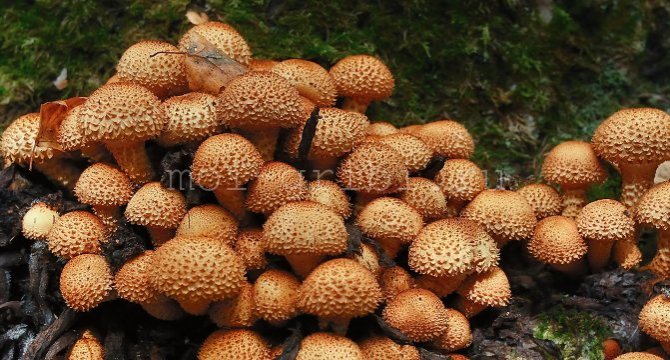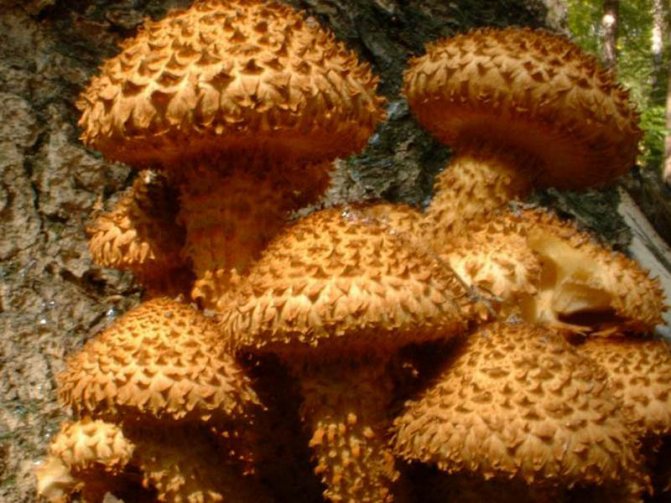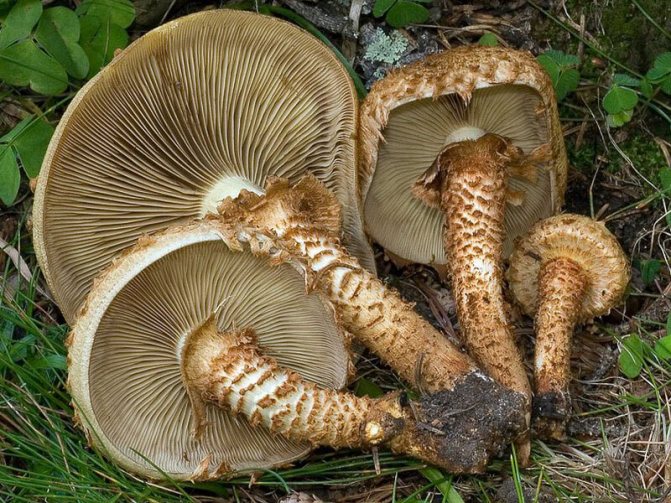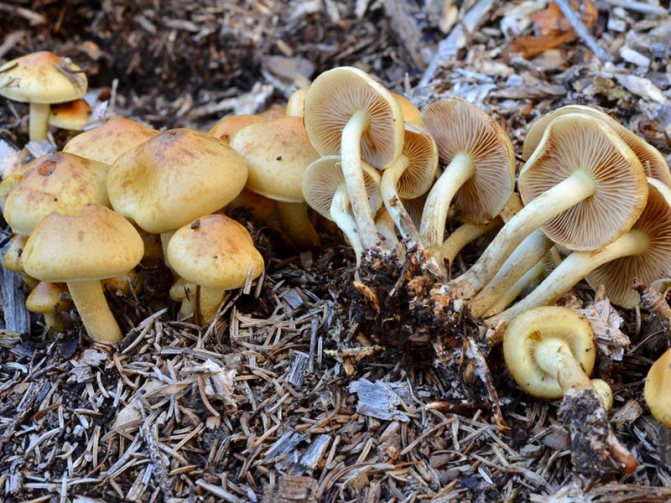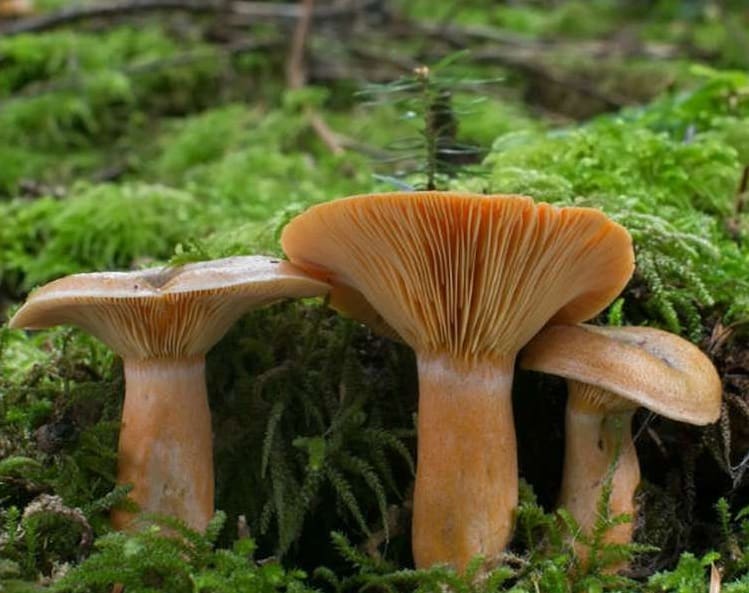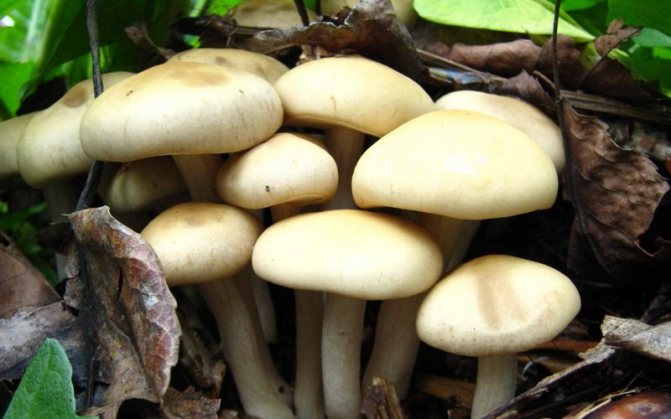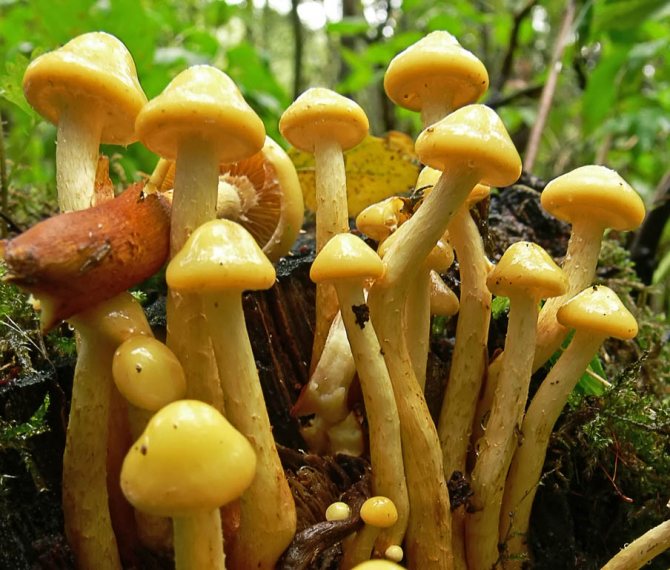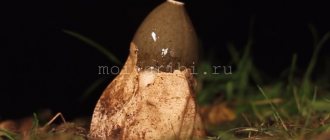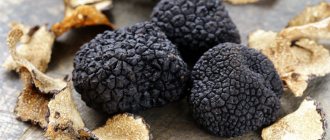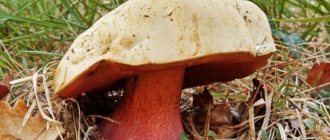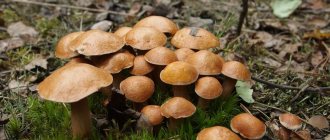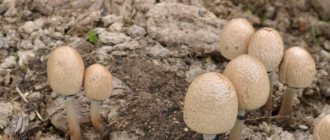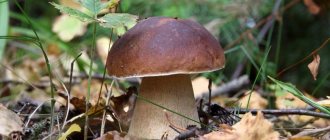Scales (foliota, royal honeydew, willow) are mushrooms of the stropharia family. These bright "thorny" mushrooms adorn the autumn forest. In our country, it is not customary to collect and eat foliots, but in Japan and China they are cultivated on an industrial scale.
These mushrooms are mostly inedible because they have an unpleasant taste and odor in the pulp. However, mushrooms of those species, the pulp of which is edible, are appreciated by experienced mushroom pickers and are used by them on a par with real mushrooms.
Botanical description
Mushrooms of the scaly genus are cap-toothed. The caps are hemispherical in young specimens and almost flat in mature specimens. Their surface of yellow-brown shades has a distinctive recognizable feature - protruding scales. It is for this feature that the mushrooms got their name. The diameter of their caps ranges from 5 to 18 cm (depending on the species). The plates on the underside of the caps are dense, adherent, of various shades of yellow or brown. Spore powder orange. The pulp of the foliota is brown in color, has a bitter taste and a radish smell. Most members of this genus are inedible, only a few species are conditionally edible. No poisonous specimens were found by mycologists among foliotics.
The mushroom legs are high (up to 12 cm), cylindrical, often narrowed at the base, painted in the same color as the caps. Closer to the cap there is a ring in the form of flakes, below the ring the legs are covered with scales.
These mushrooms grow everywhere on trees and stumps in deciduous forests, forest plantations, parks. Fruiting in July-November.
Where they grow, in what forests and how to collect
You may be interested in: Chaga birch mushroom: use, useful properties and contraindications Boletus mushrooms: photos and descriptions, varieties, useful properties Purple ryadovka mushroom: description, edibility, similar species to the photo
Scales grow mainly in deciduous forests (less often in conifers) in small groups. They can also be found in park areas within the city. You need to look for mushrooms near the roots of deciduous trees, on stumps and trunks of dying plants, etc. Sometimes flakes can be found under pines or spruces, but such mushrooms will be bitter, so you should not collect them.
In our area, these mushrooms are quite common and are found everywhere. There are especially many of them in the forests of Siberia and the Far East. They also grow in the Krasnodar Territory, Primorye and the Caucasus. Abroad, flakes are common in Europe, America and Asia.
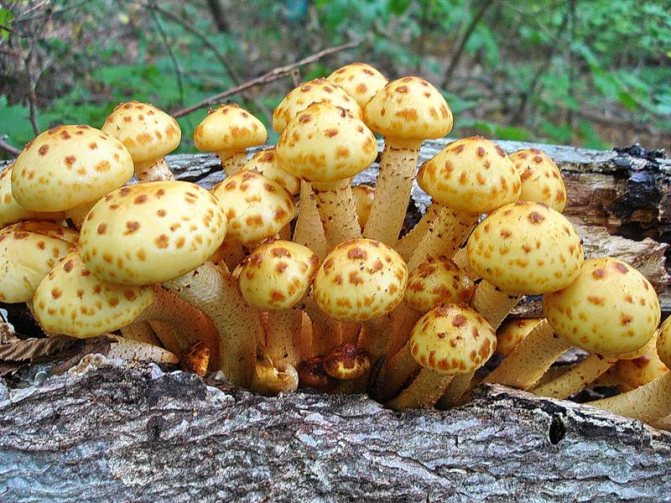
Going to pick mushrooms, you need to take a sharp knife with you. It is important to cut off the found fruit bodies as carefully as possible so as not to damage the rhizome. You need to collect all the fruits in the family at once, since small specimens will not survive on their own.


Types of scales
The genus of flakes has about 150 species, of which about 30 grow in the forests of Russia. The most common types are foliots: ordinary, golden, fiery, cinder, alder, gum-bearing, destructive, edible (hint).
Common scaly
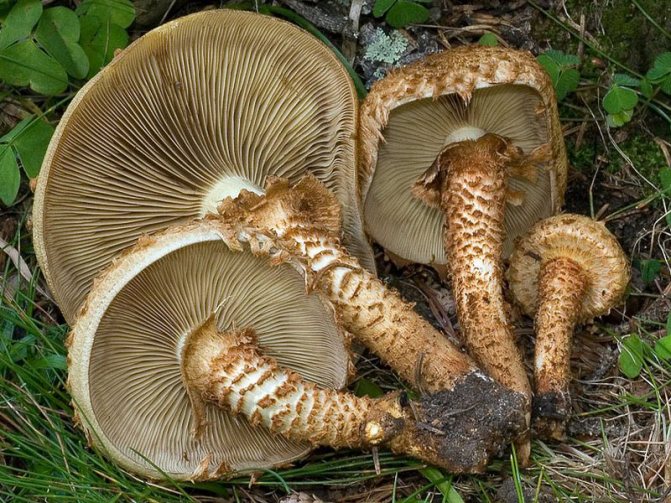

This is the most common type. Mushrooms of this type are also called fleecy, scaly, dry.They grow in colonies on the wood of living and rotten deciduous trees. The hats have a diameter of 6-10 cm, in young ones they are hemispherical, in mature ones they are flat. The surface of the caps is pale yellow with pronounced orange-brown scales.
The leg is cylindrical, dense, rusty. Young specimens have a private veil that breaks when ripe, forming a ring on their stem and flakes around the edges of the cap.
The flesh of this species is fleshy, white or yellow, although edible, but tastes bitter.
Scale golden (royal honey mushrooms)
The golden species is one of the largest representatives of the foliot: the diameter of the cap can reach 18 cm. Their fruit bodies are colored bright yellow, golden. The surface of the cap is covered with mucus and small dark brown scales. In young specimens, the cap has a hemispherical shape with tucked edges; in adulthood, it is a saucer shape with a convex center.
The pulp of these foliots does not smell or taste bitter, so the mushroom is considered edible.
Flame scale
This is an inedible type of foliot. Mushrooms of this species are smaller than ordinary or golden ones: the diameter of the caps does not exceed 7 cm. The caps are painted in reddish tones and are covered with thick curled scales of a lighter color than the cap. The scales on the cap form a pattern of ovals. The pulp is fleshy, hard, yellow in color, when broken, it becomes brown, has an astringent bitter taste and an unpleasant odor, therefore it is not eaten. Fruiting from mid-July to late September.
Cinder flakes
Cinder flakes are also called coal-loving ones. The caps of this type of mushroom are often stained with soot and dirt, since burnt trees and fireplaces are their favorite places of growth. Soot, dust and dirt adhere to the mucous surface of the caps, so the mushrooms quickly turn dirty yellow or dirty brown. In young foliots, the caps are covered with a private veil; in mature foliots, the remains of this veil are preserved in the form of a ring on the stem and along the edges of the cap. The legs are covered with small reddish scales. The pulp of these foliots is dense, tough, light yellow, and has no specific taste or smell. There is no information on the edibility of these mushrooms in the literature. They grow from August to October.
Alder flakes
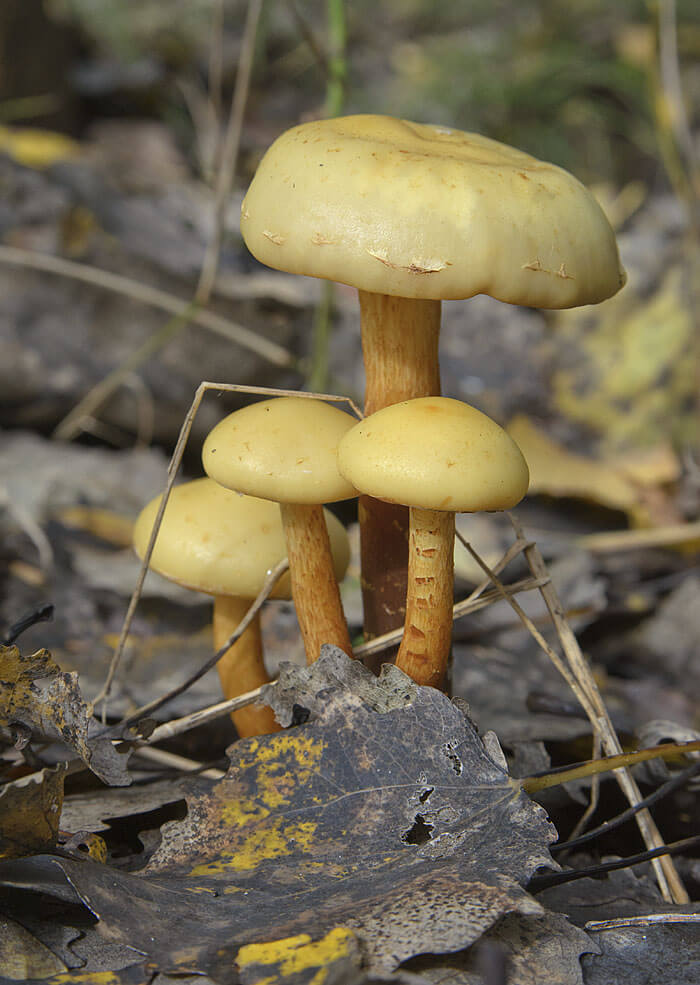

These foliots are also called the alder moth. They are often found on stumps and wood of alder or birch. The size of the moth caps is small: it does not exceed 5-6 cm. The color of the caps is yellow-orange, along their edge there are flaky remnants of a private bedspread. The legs are curved, have a pronounced ring. Below the rings are fibrous, above the rings are smooth.
The pulp of the mushrooms is yellowish, dirty yellow, inedible. When eaten, moths can cause poisoning. Fruiting in August-September.
Scaly gummy
These mushrooms are also called yellow-green because their fruiting bodies, covered with scales, are light yellow to yellow-green in color. The diameter of the caps of gum-bearing foliots is 3-6 cm. The pulp is edible, since it does not have a rare taste and odor specific to scales.
They grow on old stumps and rotten wood of deciduous trees. Fruiting in August-October.
Destructive scales
These mushrooms are often found on old and dry poplars, therefore their second name is poplar or poplar foliot. These mushrooms, in the process of their growth, actively destroy the wood of the tree. Caps can reach 20 cm, are light brown or yellowish, covered with white scales. Legs are thinned towards the top, have bulges at the base. The legs are the same color as the caps and are also covered with scales.
The pulp of the destroying foliot is inedible because it has an unpleasant odor and a bitter taste. Fruiting in August-November.
Edible flakes
This type of foliot is industrial. Mushrooms of this species are cultivated on a large scale in Japan and China. Their second name is foliot or hint of honey. Grown in rooms with high humidity - 90-95%. They grow in groups. The sizes of these mushrooms are small - no more than 2 cm in diameter. The color of the fruit bodies is orange-brown, the surface is covered with thick dense jelly-like mucus.
They have soft pulp, similar in taste and smell to real honey mushrooms. On the shelves of our stores, you can often find pickled edible flakes of Chinese production. Only the inscription on the bank says that it is mushrooms (the second name for edible scales). Pickled foliots differ from real honey mushrooms in a slimy marinade, which is due to the jelly-like coating of the caps of the latter.
Spread
Many mushroom pickers are interested in the question of where the common flake grows. She loves to grow in temperate climates, in a humid environment. In our country, it can be found almost everywhere.


The presented mushroom grows in North America, Western Europe, Karelia, and the Far East. He prefers the climate of the temperate continental zone. It can often be found on dead tree trunks. Most often it is found in deciduous and coniferous forests on the roots. Also, mushrooms of this species grow on stumps or in hollows.
They feel best in quiet, remote places. It can be a dimly lit forest, areas of forest with dense vegetation. In rare cases, mushrooms of this species can be found in illuminated places. They love shade. Therefore, in such places one should look for the presented species.
Under favorable weather conditions (in rainy weather), the presented species of mushrooms can also be found on lighted lawns. They most often spread abundantly over dead or rotting wood.
Chemical composition
The pulp of royal honey agarics (golden scales) contains the main nutrients:
- proteins - 2.2 g;
- fats - 1.2 g;
- carbohydrates - 5.6 g, of which 5.1 g are dietary fiber.
The low content of carbohydrate substances determines their low calorie content: only 22 kcal per 100 g of mushrooms.
In addition to nutrients, the pulp of these mushrooms contains many vitamins and minerals.
Vitamins and minerals
| Name | Content in 100 g of pulp, milligrams |
| Vitamin B1 (thiamin) | 0,02 |
| Vitamin B2 (riboflavin) | 0,38 |
| Vitamin PP (nicotinic acid) | 10,3 |
| Vitamin C (ascorbic acid) | 11,0 |
| Vitamin E (tocopherol) | 0,1 |
| Potassium | 400,0 |
| Calcium | 5,0 |
| Phosphorus | 45,0 |
| Magnesium | 20,0 |
| Sodium | 5,0 |
| Iron | 0,8 |
In terms of nutritional value, edible foliots belong to the very last (fourth) food category, that is, to mushrooms of mediocre taste.
Beneficial features
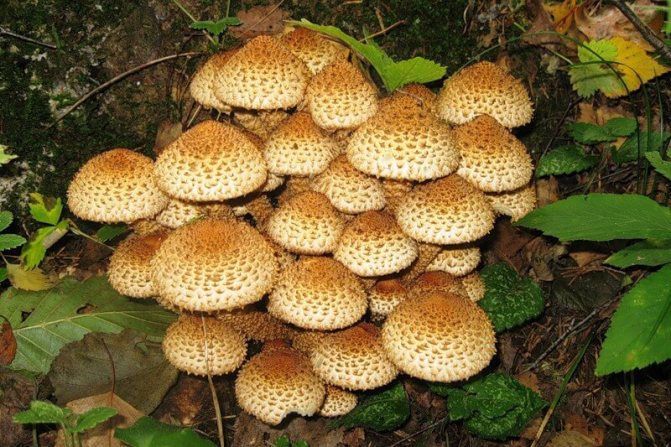

The pulp of royal mushrooms is good for health, because, with its low calorie content, it contains the entire spectrum of essential amino acids, and in terms of the amount of phosphorus and calcium, it is comparable even to fish fillets.
Due to the presence of iron and magnesium in the pulp, these mushrooms are involved in the processes of hematopoiesis, normalize the conduction of impulses along nerve fibers, affect the synthesis of proteins in the human body and are catalysts for various chemical reactions.
In golden, gummy and edible foliots, substances were found that exhibit bactericidal and antifungal effects. The mucus covering the surface of the fruit bodies of golden and edible scales has the following properties:
- stimulate cerebral circulation;
- improve immunity;
- relieve fatigue;
- restore vitality.
The flakes contain squarrozidine, a unique compound that inhibits the xanthine oxidase enzyme. The enzyme xanthine oxidase promotes the crystallization of uric acid in joints, kidneys and body tissues.By inhibiting this enzyme, squarrozidine prevents the loss of urate salts and thus prevents pain attacks in people with gout. In clinical practice, drugs containing a xanthine oxidase inhibitor as an active ingredient are used to treat gout.
There is evidence that drugs made on the basis of these mushrooms are capable of exhibiting anti-cancer properties.
Potential harm
In addition to useful properties, royal mushrooms can also exhibit harmful effects on the human body. Their harm can be caused by various factors:
- Refers to inedible types of flakes.
- Collected in places with unfavorable environmental conditions (near landfills, cattle burial grounds, along roads, in industrial zones).
- They are overripe or wormy.


Eating edible flakes is contraindicated in case of individual intolerance and allergies.
With gastritis, pancreatitis, cholecystitis and renal impairment, eating foliot can cause an exacerbation.
Children's age, the state of pregnancy and the period of breastfeeding are also absolute contraindications to the use of foliot in food.
It is strictly forbidden to eat royal mushrooms and alcoholic beverages at the same time. It has been scientifically established that when they are taken simultaneously, a disulfiram-like (coprinous) syndrome develops.
This syndrome manifests itself in the form of symptoms of acute intoxication with intermediate alcohol decomposition products:
- rush of blood to the face;
- tinnitus;
- nausea and vomiting;
- stomach pain;
- an increase in body temperature;
- heart palpitations;
- difficulty breathing;
- panic.
In severe cases, collaptoid conditions, coma, or respiratory arrest may develop.
The pulp of these mushrooms also contains meconic acid, which is derived from opium. Therefore, in some cases, when eating royal honey mushrooms without preliminary boiling, psychedelic states can develop, accompanied by auditory and visual hallucinations.
Habitat
As for habitats, most often royal mushrooms are found on the surface of fallen, but still living trees or stumps. Spores can also get on the roots of growing trees and multiply there. The culture is considered a parasite and develops only on deciduous plants, if you find similar fruits on coniferous wood - it is better to pass by and refrain from harvesting.
Flakes are also harvested abroad, and in China and Japan, the royal honey fungus is grown purposefully, on an industrial scale.
Application in traditional medicine


Medicines (decoctions, infusions, tinctures) are prepared from foliot, which are used by traditional healers in the treatment of diseases of the cardiovascular system (atherosclerosis, arterial hypertension, varicose veins, thrombophlebitis). Iron and magnesium foliot contribute to an increase in hemoglobin levels, so the introduction of these mushrooms into the diet will be beneficial for anemia and thyroid diseases.
Due to the large amount of fiber in the pulp, royal mushrooms prevent constipation. The presence of squarrozidine in the pulp of royal honey agaric makes them an indispensable food for people suffering from gout. Means from the fire in folk medicine are used as an emetic and laxative.
Due to their low calorie content, royal mushrooms are included in the diet of diabetics, vegetarians and people on a diet. It is scientifically proven that the extract of fresh golden foliot inhibits the growth of Ehrlich's carcinoma and sarcoma-180 in laboratory mice.
Cooking applications
In cooking, only ordinary, golden, gummy foliots and honey mushrooms are used, because they have a pulp with a pleasant smell and a typical mushroom taste, similar to the taste of real mushrooms.
These mushrooms can be cooked in a variety of ways:
- add to soups, main courses, baking fillings, sauces and salads;
- fry;
- marinate;
- salt.
It is not customary to dry the flakes.
Preparing fresh foliots is not worth it: they can cause dyspeptic symptoms. Before cooking, royal mushrooms must be boiled so that these digestive problems do not arise. The broth of the mushrooms must be drained.
You can eat the entire fruiting body of the mushroom, but experienced chefs recommend taking caps for hot dishes, and the whole body for pickling and pickling.
Golden scale recipes
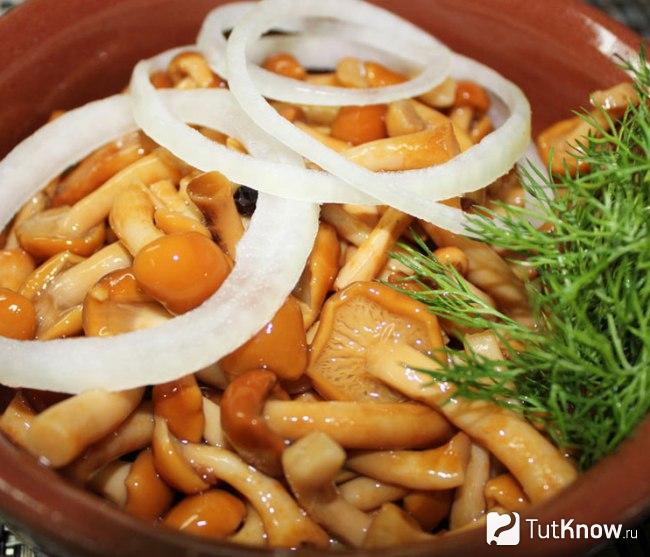

Before preparing the main course, royal mushrooms need preliminary culinary processing. The legs are cut almost completely, then the mushrooms are soaked for at least 20 minutes to completely remove debris and insects that have got into the plates. Then they are boiled in salted water and put in a colander so that the glass has excess moisture. It is believed that during preliminary cooking it is necessary to put an onion in a saucepan: if it darkens, then a poisonous honey fungus has "crept in" among the mushrooms. Unfortunately, it is impossible to identify a poisonous individual in this way.
Golden Scale Recipes:
- Pickled mushrooms
... Prepared mushrooms are boiled 2 more times for 20 minutes, each time rinsing with running water and filling with new ones. The jars are sterilized along with the lids, while the marinade is boiled. Proportions: 1 kg of mushrooms, pure water - 600 ml, salt - 2 tablespoons, the same amount of sugar, 12 black peppercorns, 5 bay leaves and vinegar 9% - 2 tablespoons. The marinade is boiled for 5 minutes, 3-4 crushed large cloves of garlic are added, boiled for another 2 minutes. Mushrooms are transferred to jars, poured with boiling marinade and the lids are tightened. Preservation is put to cool upside down, under the blanket. - Golden flakes in sour cream
... Pre-prepared mushrooms in an amount of 1 kg are spread in a colander or paper towels to remove the remaining moisture, cut a large onion into rings and fry it in vegetable oil until golden brown. Spread the mushrooms, fry for 15 minutes, pour half a glass of fatty, preferably rustic, sour cream into the pan, and stew for 30 minutes. Then sprinkle the fry with chopped herbs - dill and parsley, cover with a lid and let the dish brew for at least 15 minutes. Serve with fried or boiled potatoes. - Chicken soup with honey agarics
... Honey mushrooms are prepared in the usual way, boiling for at least 20 minutes. Finely chop the onions and carrots - it is more convenient to use a blender, as when grated on a grater, the onions "sting" the eyes. Cut the potatoes into small cubes. It is advisable to finely chop the chicken meat and boil it: put the chicken in boiling water, supplement the container with a whole onion, boil for 15 minutes. At this time, the onion-carrot mixture is fried in a pan with sunflower oil, mushrooms are added and also fried, 15 minutes. Remove the onion from the chicken broth, lay the potatoes, fry in full and cook until tender. To improve the taste, bay leaves, black and allspice peppers, and salt are used. It is better to sprinkle with herbs the soup, already poured into plates. - Royal mushrooms in a slow cooker
... In a modern multicooker pan, you can pre-cook royal mushrooms and prepare a main course. The washed mushrooms are laid out in a bowl, put on a simmer for 30 minutes, and then put on a steamer device. While the liquid is draining, chop the onion and carrots. Preheat the bowl on the "frying" mode and pour all the ingredients into it together. The dish can be tasted after 40 minutes - salt, pepper and add herbs to taste. - Salad with golden flakes
... Boiled chicken fillet marinated in soy sauce. Boil diced potatoes, cut carrots.Pickled mushrooms are washed, cut into identical pieces. Stir potato cubes with carrots, mushrooms and fillet pieces. A large onion is cut into rings, each ring is rolled in flour, fried until golden brown, the parsley is washed and torn by hand. The salad is garnished with fried onion rings and parsley sprigs. - Diet puree soup
... Cut potatoes, boil until half cooked, sauté onions and carrots in a pan with a minimum amount of sunflower oil. Pre-prepared mushrooms are fried with onions and carrots for 20-25 minutes under a lid. The potatoes are removed from the water - the broth is not poured out, combined with frying, chopped with a blender. Bring the water to a boil, put the grated mass into it, mix well and leave to infuse under the lid, pouring in half a glass of heavy cream. Salt to taste, herbs are added to each plate.
From golden scales, you can prepare a filling for pies, add to a casserole. Mushrooms are harvested for the winter not only by pickling, but also by freezing. Pre-treatment of thawed mushrooms is carried out in the same way as fresh ones.


